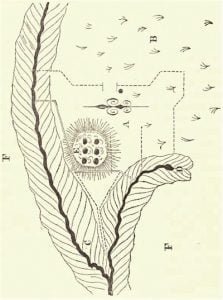
Some years have elapsed since I visited this work, 1 and the plough and spade may have further obliterated the lines, then more or less fully apparent. But in the meantime no notice of it has been published. The following outlines denote its extent and character.
A. indicates the lines of a picketed work. B. is an extensive plain, covered with wild grass and some shrubbery, which had once been in cultivation. The northern edge of this plain is traversed by a stream, which has worn its bed down in the unconsolidated strata, so as to create quite a deep gorge, C. This stream is joined from the west, by a small run, having its origin in a spring, D. Its channel, at the point of junction, is as deep below the level of the plain as the other. 2 The point of junction itself forms a natural horn-work, which covered access to the water. The angle of the plain, thus marked, constituted the point defended. The excavations E. may have once been square. They are now indentations, disclosing carbonaceous matter, as if from the decay of wood. No wood, or coal, however, existed. Their use in this position is not apparent, connected with the designated lines of palisades, unless it be supposed that they were of an older period than the latter, and designate pits, such as the aborigines used in defense. This idea is favored by the ground being a little raised at this point, and so formed that it would have admitted the ancient circular Indian palisade. If such were the case, however, it seems evident that the spot had been selected by the French, at an early period, when, as is known, they attempted to obtain a footing in the country of the Oneidas. The distance is less than ten miles northwest of Oneida Castle. It probably covered a mission. The site, which my informant, living near, called the Old French Field, may be supposed to have been cultivated by servants or traders connected with it.
The oak and maple trees, which once covered it, as denoted by the existing forest, F. F., are such, in size and number, as to have required expert axmen to fell.
With the exception of two points, in the Oneida Creek valley, where there are still vestiges of French occupation, supported by tradition, this work is the most easterly of those known, which remain to testify the adventurous spirit, zeal and perseverance which marked the attempt of the French crown to plant the flag and the cross in western New York.
The bold nature of this scheme to colonize the country, and bring the Iroquois to acknowledge their dependence upon France, and the importance of the experiment and the issue, cannot be well conceived without reference to the history of those times. Pending the famous expedition of the Chevalier de Vandreiul, 1696, into the Iroquois country, it is known that the Jesuit Milet was stationed among the Oneidas, over whom he had so much influence, that soon after the termination of this vain display of power, thirty Oneidas deserted to the French, and desired that Milet might be appointed their pastor. 3
Citations:
- 1812.[
]
- Some few miles below this stream is the site of an iron cupola or blast furnace, where the red or lenticular oxyd is reduced.[
]
- Colden s Five Nations, p. 193.[
]
